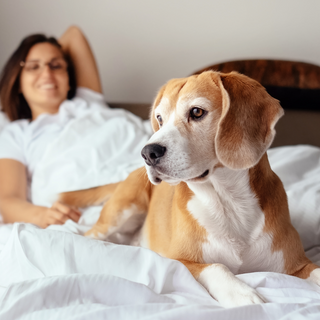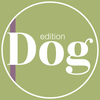Masks, Movement, and Mystery
Halloween is the night the familiar becomes strange. The scent of pumpkin and candle wax mingles with cold air; doorways flicker with shadows; voices change shape behind masks. For us, it is harmless fun, an evening of performance, nostalgia, laughter.
For dogs, it can feel like the world has slipped its skin.
When we put on masks and costumes, we alter the very signals that dogs depend on for safety. We hide our faces, distort our scent with makeup or synthetic fabrics, move differently, speak in strange tones. The result is a world suddenly filled with contradiction, people who sound familiar but look wrong.
To a dog, who reads trust through eyes, posture, and movement, this is not entertainment. It is sensory dissonance.
The Science of the Strange
Fear of the unfamiliar, neophobia, is a natural, even necessary, survival instinct. In wild canids, hesitation before new sights, smells, or sounds prevents reckless interaction with danger. Domestic dogs retain this neural circuitry; it sits deep in the amygdala, the brain’s threat detection centre.
When something defies expectation, when a human face changes shape, when movement becomes erratic, when familiar scents are masked, the brain’s limbic system sends an alert. Cortisol rises, heart rate quickens, and behaviour shifts from curiosity to caution.
Humans can override this response with reason: It’s just a costume.
Dogs cannot. For them, sensory mismatches mean uncertainty. The person in front of them may sound like someone they love, but the outline, smell, and micro-movements all say otherwise. The brain cannot reconcile the two realities, and anxiety fills the space in between.

The Face as a Compass
Dogs are expert readers of the human face. They study the tiniest muscle twitches, the lift of an eyebrow, the tightening of the jaw, the angle of gaze. These details provide social orientation: who is calm, who is angry, who is safe.
In MRI studies, dogs show specific neural activation when viewing human faces, particularly in regions linked to social bonding. In essence, they have evolved to recognise us as emotional landmarks. Your face is your dog’s compass, it tells them where they are in the world.
A mask erases that compass. The eyes may vanish behind plastic; the mouth freezes in a false grin; the fabric deadens scent. The brain, expecting connection, finds only distortion. For a species that depends on honesty of expression, a mask is a lie.
It’s why some dogs bark at people wearing hats or sunglasses, small changes can disrupt recognition. Multiply that by a street full of costumed figures, and you begin to glimpse the sensory chaos of Halloween through canine eyes.
Movement as Meaning
Dogs also read movement with extraordinary precision. They notice shifts in weight, direction, and rhythm long before words or intentions form. Smooth, predictable motion signals calm. Sharp, irregular movement, the jerky dance of a costume-clad child or the lunge of a waving cape, triggers the opposite.
From an ethological perspective, erratic motion mimics threat. Predators or aggressors move unpredictably; safe social partners move steadily. When children run screaming across driveways in glowing masks, dogs perceive neither joy nor play, only chaos.
Even inside the home, where the smell of roasted pumpkin blends with candle smoke, dogs may struggle to interpret the sudden bursts of laughter or squeals at the door. Their world, normally patterned and predictable, has become a storm of signals.
The Collapse of the Familiar
To understand Halloween from a dog’s perspective, imagine walking into your kitchen and finding that every object looks slightly different, every sound carries an echo, every person speaks through a filter. Nothing has changed in essence, but nothing feels safe either.
This is the collapse of familiarity. Dogs thrive on consistency, same paths, same faces, same tones. Routine is not boredom for them; it is security. Halloween shatters that predictability overnight.
And yet, what they crave most on such nights is not distance but translation. They look to us for cues: Is this safe? Is this still home? Can I trust this world again?
Reclaiming Safety as Ritual
Empathy, not control, is the antidote. Preparation for Halloween shouldn’t begin with fear of fireworks or trick-or-treaters, but with recognition of how radically we alter the sensory environment.
If we are to dress up, we can show our dogs the costume gradually, let them sniff it, watch us put it on and take it off, hear our voice through it before the evening begins. This teaches the brain that the mask does not replace the person; it overlays them.
Within the home, create continuity. Keep familiar lighting, maintain scent cues, the same bedding, the same blanket. Dogs locate safety through smell as much as sight; one unwashed jumper can anchor them amidst chaos.
And when the doorbell rings, remember: excitement to us is adrenaline to them. A dog’s nervous system doesn’t distinguish between “fun noise” and alarm. Calm presence, slow breathing, steady movement, these are the true reassurances.
Halloween empathy begins with quiet leadership: not “protecting” the dog through isolation but grounding them through consistency.
Beyond Fear
In truth, Halloween offers us a mirror. It reminds us how much of our relationship with dogs depends on trust built through predictability, openness, and clear communication. When we hide behind masks, literal or emotional, we momentarily break that contract.
Dogs love us for our transparency. Our faces, our scents, our routines, these are the architecture of their safety. When those change, even briefly, they teach us just how much that safety matters.
So as the pumpkins flicker and the streets fill with mystery, take a moment to look at the world through your dog’s eyes.
Feel the strangeness, the loss of cues, the longing for the familiar. Then offer it back, a hand to smell, a calm voice, a still body.
Because when we hide our faces for fun, our dogs lose their map of who to trust.
When we reveal them again smiling, open, real, we remind them that underneath all the noise and colour, love still looks, smells, and feels the same.
- Choosing a selection results in a full page refresh.


